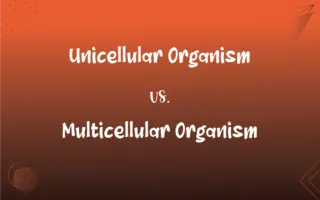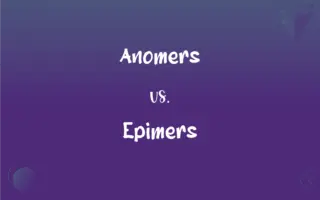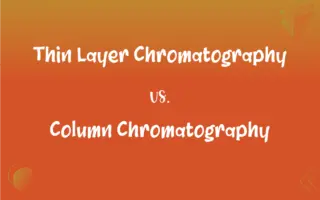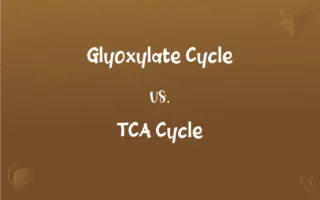Agglutination vs. Coagulation: What's the Difference?
Edited by Aimie Carlson || By Harlon Moss || Updated on October 28, 2023
Agglutination is the clumping of particles, often in response to an antigen, while coagulation refers to the clotting of blood or liquid.

Key Differences
Agglutination and coagulation are two processes related to the reaction of particulate substances within a liquid medium. Agglutination typically refers to the clumping together of cells, usually in response to a specific antigen or other foreign substance. On the other hand, coagulation is the process by which blood or another liquid turns from a fluid state to a gel-like or semi-solid state, forming a clot.
In the medical and laboratory setting, agglutination tests are commonly used to determine the presence of specific antibodies in a sample. When an antigen is introduced, if corresponding antibodies are present, agglutination occurs. Coagulation, however, is crucial in wound healing, as it prevents excessive bleeding by forming a clot at the injury site.
Furthermore, while agglutination often involves the interaction of antibodies and antigens, resulting in visible clumps, coagulation is a more complex cascade involving numerous clotting factors that work together to stabilize a clot. It's essential for maintaining hemostasis, the balance between bleeding and clotting.
It's interesting to note that while agglutination can be a purposeful and diagnostic tool in laboratory settings, excessive coagulation can lead to health risks, such as thrombosis or embolism. Both processes, agglutination and coagulation, highlight the intricate balance our bodies maintain to respond to injuries and foreign substances.
Both agglutination and coagulation play vital roles in healthcare. For instance, blood typing relies on agglutination reactions, ensuring safe blood transfusions. In contrast, understanding coagulation is key to addressing bleeding disorders and managing conditions that predispose individuals to clot formation.
ADVERTISEMENT
Comparison Chart
Definition
Clumping of particles in response to antigens.
Clotting of blood or liquid.
Main Agents Involved
Antibodies and antigens.
Clotting factors, platelets.
Primary Context
Blood typing, diagnostic tests.
Wound healing, maintaining hemostasis.
Resultant Form
Visible clumps of cells or particles.
Gel-like or semi-solid clot.
Potential Health Implications
Used as a diagnostic tool; no direct health risk from the process.
Excessive coagulation can lead to thrombosis or embolism.
ADVERTISEMENT
Agglutination and Coagulation Definitions
Agglutination
Agglutination is the clumping of particles or cells.
The agglutination test confirmed the presence of specific antibodies in the blood.
Coagulation
Coagulation is the process of blood clotting.
The wound stopped bleeding due to the body's natural coagulation process.
Agglutination
Agglutination can visually demonstrate the interaction of antibodies and antigens.
The sample showed clear agglutination, signaling a match.
Coagulation
Coagulation involves a cascade of clotting factors.
The coagulation cascade is a complex series of events leading to clot formation.
Agglutination
Agglutination occurs when antigens bind to their corresponding antibodies.
Visible agglutination indicated a positive reaction to the introduced antigen.
Coagulation
Coagulation maintains hemostasis in the body.
Disruptions in coagulation can lead to excessive bleeding or clotting.
Agglutination
Agglutination is a common diagnostic tool in medical labs.
We use agglutination tests to determine blood types.
Coagulation
Coagulation can transform blood from a liquid to a gel-like state.
During coagulation, the liquid blood formed a semi-solid clot.
Agglutination
Agglutination reactions are essential for safe blood transfusions.
Before the transfusion, an agglutination test ensured compatibility.
Coagulation
Coagulation plays a critical role in wound healing.
Prompt coagulation ensured the cut didn't bleed excessively.
Agglutination
The act or process of agglutinating; adhesion of distinct parts.
Coagulation
To cause transformation of (a liquid or sol, for example) into or as if into a soft, semisolid, or solid mass.
FAQs
What is agglutination?
Agglutination refers to the process where particles clump together, often used in biology to describe how cells or particles adhere.
What causes agglutination?
It’s often caused by specific antibodies binding to antigens on the surface of cells or particles.
What is an example of agglutination?
A common example is blood type testing, where red blood cells clump together in response to specific antibodies.
Where is agglutination commonly used?
It’s widely used in blood typing, immunology, and certain diagnostic tests.
Is agglutination reversible?
It can be, depending on the context and the strength of the interactions involved.
What is agglutination in linguistics?
In linguistics, it refers to the process of combining morphemes into words without significant changes in form.
What role does agglutination play in immunity?
It plays a crucial role in the immune response by helping to identify and neutralize foreign substances.
How is coagulation controlled?
It's regulated by a balance of pro-coagulant and anticoagulant factors in the body.
Is agglutination the same as coagulation?
No, agglutination involves particle clumping, while coagulation refers to the clotting of blood or liquids.
What are coagulation factors?
Coagulation factors are proteins in the blood that play key roles in the clotting process.
Can agglutination be harmful?
It can be, especially in cases of incompatible blood transfusions or certain autoimmune disorders.
What is an example of coagulation?
A common example is the formation of a blood clot to stop bleeding from a wound.
What disorders affect coagulation?
Disorders like hemophilia, deep vein thrombosis, and pulmonary embolism affect coagulation.
What is coagulation in cooking?
In cooking, it refers to the process of proteins solidifying, often seen in egg cooking or cheese-making.
How are coagulation disorders treated?
Treatments vary, including clotting factor replacement, anticoagulant medications, and lifestyle changes.
What is coagulation?
Coagulation refers to the process where blood or other liquids turn into a semi-solid or solid state, forming a clot.
What triggers coagulation?
It’s triggered by a complex cascade of biochemical reactions, often initiated by tissue injury.
Is coagulation always beneficial?
While it's crucial for stopping bleeding, excessive or inappropriate coagulation can lead to harmful clots.
How is agglutination detected?
It's often detected visually or using specific laboratory techniques like agglutination assays.
What is the coagulation cascade?
It’s a series of reactions involving coagulation factors that lead to the formation of a blood clot.
About Author
Written by
Harlon MossHarlon is a seasoned quality moderator and accomplished content writer for Difference Wiki. An alumnus of the prestigious University of California, he earned his degree in Computer Science. Leveraging his academic background, Harlon brings a meticulous and informed perspective to his work, ensuring content accuracy and excellence.
Edited by
Aimie CarlsonAimie Carlson, holding a master's degree in English literature, is a fervent English language enthusiast. She lends her writing talents to Difference Wiki, a prominent website that specializes in comparisons, offering readers insightful analyses that both captivate and inform.




































































